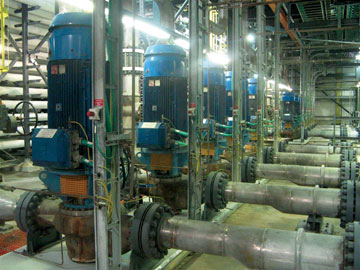|
NEWS NOTES
Good to drink, not good for crops
 Dimitri Gilburd |
| Israel’s Ashkelon desalination plant is one of the largest desalination facilities in the world. |
Desalinated seawater is a growing solution for many dry and coastal nations thirsting for freshwater, both to drink and to irrigate crops. Recent research on crops irrigated by desalinated seawater, however, suggests that what’s good for human consumption isn’t so good for plants.
Israel’s Ashkelon facility on the Mediterranean Sea is one of the largest, most technologically advanced desalination facilities in the world. Built to combat Israel’s drinking water shortage, Ashkelon supplies 100 million cubic meters of desalinated water each year — about 15 percent of the total water consumed in Israel — according to IDE Technologies, Ltd. IDE is one of two partners in V.I.D. Desalination (with Veolia Water in Paris, France), which built the facility.
Before the Ashkelon facility opened in 2005, it was “unimaginable” that its water might negatively affect farmers’ crops, says environmental scientist Alon Tal of the Ben-Gurion University of the Negev in Israel. The water is treated to meet specifications for human consumption, but because the population of southern Israel is relatively sparse, some of the water was also diverted to irrigate crops in the dry Negev region.
While studying crops that had been irrigated by the desalinated water, however, plant and soil scientist Uri Yermiyahu of the Gilat Research Center in Negev, Israel, discovered something surprising: Many of the tomato, basil and flower crops suffered from a magnesium deficiency. Furthermore, high levels of boron in the water were reducing the yields of tomato and peanut crops.
Desalination doesn’t just take out salts from the water, but also removes certain ions that are basic nutrients, including calcium, magnesium and sulfate. To combat the removal of calcium, which humans and plants both need, the treatment process adds calcium back to the water so that it meets established drinking water standards.
Those standards are much lower than what plants need, however, Yermiyahu, Tal and a team of researchers reported Nov. 9 in Science. Another nutrient, sulfur, is also added at Ashkelon and some other treatment facilities around the world to help dissolve and remove calcium carbonate (which creates “hard water”) — that addition is sufficient for some plants, but not others, they reported.
Furthermore, some desalination plants use a different process to dissolve calcium carbonate, which does not involve sulfur. That could be problematic if the water is used for agricultural irrigation, says Ori Lahav of Technion in Haifa, Israel, another author on the paper.
Boron is a different problem. Seawater from the Mediterranean Sea, which supplies the Ashkelon facility, is naturally high in boron, which is not fully filtered out during the reverse osmosis treatment the facility uses. The remaining boron in the water is safe to drink, as it is still well below the maximum concentrations for human consumption as defined by the Israeli Water Desalination Authority, says Fredi Lokiec, the marketing manager at IDE. Although the boron levels in the water after treatment are fine for humans, they are toxic to most crops, the team reported.
That Ashkelon’s desalinated water doesn’t meet agricultural needs is not a failure of its design, as it was originally intended to provide only drinking water, says Alon Ben-Gal, also of the Gilat Research Center and a co-author on the study. “If experts had been asked what would be the result of agricultural use of the water, they certainly would have warned that the low levels of calcium, magnesium and sulfur could be problematic,” Ben-Gal says. Brackish water in Israel intended for irrigation is commonly treated to take such nutritional needs of crops into account, he adds. “We are definitely not implying that desalination is bad for agriculture — only that it needs to be managed correctly.”
Altering the specifications for desalinated water quality to make it suitable for agriculture might be good for humans, too. The World Health Organization recently recommended that some minerals, including calcium and magnesium, be added to desalinated water to help prevent cardiovascular diseases, Lahav says. Furthermore, the reverse osmosis process removes only 60 percent of the boron in Mediterranean seawater, which meets Israel’s drinking water standards, but not the more rigorous standards set in 1998 by the European Union, says Avner Vengosh of Duke University in Durham, N.C., who was not involved with the study. Whether high boron concentrations in water are harmful to humans is still unclear, however — although high levels of boron have caused reproductive and developmental problems in some animal studies, there are no proven effects on humans, Vengosh says.
Future desalination plants should consider building in processes that can optimize water quality for both uses, Tal says. “We want to flag this issue,” he says, because desalination is going to play a significant role in meeting increasing worldwide demands for more crop productivity to supply both food and biofuels.

 Subscribe
Subscribe


